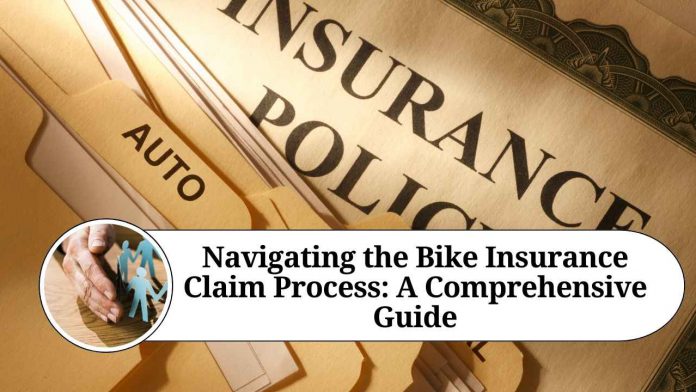Introduction
Owning a bike can be an exhilarating experience, but it also comes with responsibilities, including protecting your prized possession with bike insurance. Accidents and unforeseen events can occur at any time, leaving your bike damaged or in need of repairs. In such situations, having a clear understanding of the bike insurance claim process is crucial. In this comprehensive guide, we will walk you through the steps involved in filing a bike insurance claim, ensuring a smooth and hassle-free experience.
Understanding Bike Insurance Policies:
Before delving into the claim process, it’s essential to familiarize yourself with the various types of bike insurance policies available. There are primarily two types: third-party liability insurance and comprehensive insurance. While third-party liability covers damages to third-party property or injury caused by your bike, comprehensive insurance offers wider coverage, including damages to your own bike.
Assessing the Damage:
Once an accident or unfortunate event occurs, the first step is to assess the damage to your bike. It’s crucial to document the incident by taking pictures and collecting all relevant information, such as the date, time, location, and the parties involved. This documentation will play a vital role in supporting your claim later.
Informing the Insurance Provider:
After documenting the incident, promptly inform your insurance provider about the accident or damage. Most insurance companies have a dedicated helpline or customer service department to handle claim intimation. Provide them with accurate details, including the policy number, date and time of the incident, and a brief description of the event. Remember to note down the claim reference number for future reference.
Filing the Claim Form:
To initiate the claim process, you will be required to fill out a claim form provided by your insurance provider. The form typically requires personal information, policy details, a detailed account of the incident, and supporting documents. Fill out the form carefully, ensuring accuracy and completeness.
Document Submission:
To support your claim, you will need to submit certain documents to your insurance provider. These may include a copy of the filled claim form, a copy of your bike insurance policy, a valid driving license, registration certificate, FIR (if applicable), repair estimate, and any other documents requested by the insurer. Make sure to keep copies of all the submitted documents for your records.
Survey and Investigation:
Once the claim form and documents are submitted, the insurance company will assign a surveyor or investigator to assess the damage and verify the authenticity of the claim. The surveyor will inspect your bike, review the accident details, and estimate the cost of repairs or replacement. Cooperate with the surveyor and provide any additional information they may require.
Cashless or Reimbursement Claim:
Depending on your policy, you may be eligible for either a cashless claim or reimbursement claim. In a cashless claim, the insurance company directly settles the repair bills with the network garages. If you opt for a reimbursement claim, you will need to pay for the repairs upfront and submit the bills for reimbursement. Check your policy documents to understand the claim settlement process.
Claim Settlement:
After completing the investigation and assessment, the insurance company will communicate the claim decision to you. If your claim is approved, the insurer will arrange for the payment or reimbursement as per the agreed terms. In case of any disputes or disagreements, refer to the terms and conditions of your policy or approach the insurance company’s grievance redressal cell.
Conclusion
Filing a bike insurance claim doesn’t have to be a daunting task if you understand the process and follow the necessary steps diligently. By promptly reporting the incident, providing accurate information, and cooperating with the insurer’s surveyor, you can ensure a smooth and hassle-free
Other Related Blogs: Section 144B Income Tax Act
Frequently Ask Question
Q. What should I do immediately after an accident or damage to my bike?
The first step is to ensure your safety and the safety of others involved. Then, assess the damage to your bike, take pictures, and collect relevant information such as date, time, location, and parties involved. Inform your insurance provider about the incident as soon as possible.
Q. How do I inform my insurance provider about the accident or damage?
Most insurance companies have a dedicated helpline or customer service department for claim intimation. Call the helpline or contact your insurance provider through their preferred channel and provide them with accurate details of the incident.
Q. What documents are typically required to file a bike insurance claim?
The documents usually required include a filled claim form, a copy of the bike insurance policy, a valid driving license, registration certificate, FIR (if applicable), repair estimate, and any other documents requested by the insurer.
Q. How long do I have to file a claim after an accident or damage?
It is advisable to inform your insurance provider about the incident and file the claim as soon as possible. Most insurance companies have a stipulated time frame for claim intimation, which is usually within 24 to 48 hours from the occurrence of the event.
Q. What happens after I submit the claim form and documents?
Once you submit the claim form and documents, the insurance company will assign a surveyor or investigator to assess the damage and verify the claim. The surveyor will inspect your bike, review the accident details, and estimate the cost of repairs or replacement.
Q. How is the claim settlement amount determined?
The claim settlement amount is determined based on the surveyor’s assessment, policy terms and conditions, and coverage limits mentioned in your insurance policy. The settlement amount may cover the cost of repairs, replacement of damaged parts, or the market value of the bike in case of total loss.
Q. What is a cashless claim and a reimbursement claim?
In a cashless claim, the insurance company directly settles the repair bills with the network garages. You won’t have to pay for the repairs upfront. In a reimbursement claim, you pay for the repairs yourself and then submit the bills to the insurance company for reimbursement.
Q. How long does it take to settle a bike insurance claim?
The time taken to settle a bike insurance claim can vary depending on various factors such as the complexity of the claim, the availability of required documents, and the responsiveness of the parties involved. Generally, it can take anywhere from a few days to a few weeks.
Q. What should I do if my claim gets rejected?
If your claim gets rejected, carefully review the reasons provided by the insurance company. If you believe the rejection is unjustified, you can approach the insurer’s grievance redressal cell and provide additional evidence or seek clarification. If the issue remains unresolved, you may consider seeking legal advice.
Q. Can I transfer my bike insurance claim to a new owner if I sell my bike?
No, you cannot transfer an ongoing claim to a new owner. The claim will remain with the original policyholder. However, the new owner can initiate a fresh claim based on their own insurance policy, if they have one.




















